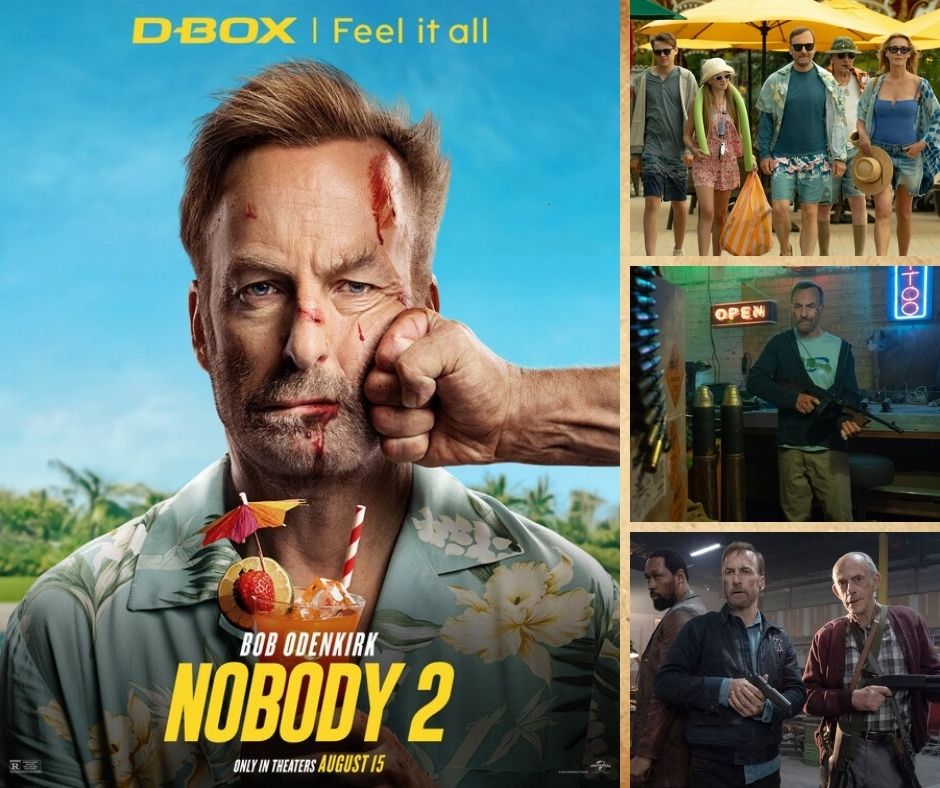Nobody 2
Why Smaller is Better

Released in March 2021 after multiple COVID-related delays, the first Nobody was a clear success for Universal, grossing nearly four times its budget worldwide despite many cinemas still being closed or operating at reduced capacity. Written and produced by the minds behind the John Wick franchise, it served as a lower-budget, more domestic cousin to that series, drawing attention for casting Bob Odenkirk (Better Call Saul) in a complete departure from what audiences knew him for. Gone were the goofy antics of Saul Goodman, replaced with a leaner, more physically imposing Odenkirk delivering surprisingly convincing action scenes. His commitment to that transformation shouldn’t be understated. That said, beyond his performance, Nobody played like a straightforward John Wick clone and left little lasting cultural footprint.
To say my expectations for Nobody 2 were low would be an understatement. I wasn’t a big fan of the first, nor am I particularly fond of the John Wick series (as my score for Ballerina can attest). I also didn’t care for Shadow Strays, the Indonesian director’s previous film. All of these share the same problem: they start at such a high intensity that there’s nowhere left to go. Once the protagonist survives those first impossible situations without serious consequences, every fight ends the same way — largely unscathed, nothing a good shower and a few hours off can’t fix. The only variation comes from changing weapons, locations, or camera tricks, but the dramatic effect stays the same. Without rising stakes or a real sense of danger, the choreography, no matter how creative, begins to feel repetitive and hollow, and I eventually check out.
Nobody 2 fixes much of that by “de-escalating” from the first. Instead of chasing larger lore and impossible escalation à la John Wick (which left the original feeling thin), this sequel opts for a smaller, self-contained story as Hutch takes his family on vacation to Plummerville, a tourist town hiding a criminal operation he inevitably gets pulled into.
The smaller setting and tighter scope make the movie feel lighter and more relaxed, even as the bigger budget allows for more ambitious set pieces. At a brisk 90 minutes, it never overstays its welcome, and the contained location becomes a strength. Small moments, like debating a trip to the water park or bickering over room arrangements, are as engaging as a good sitcom.
In a blockbuster landscape obsessed with interconnected worlds and constant expansion, it’s easy to assume that if a sequel isn’t “growing the universe,” it’s not justifying its existence. Nobody 2 makes a better case: it’s worth returning simply to spend time with these characters.
The protagonist remains the highlight, with Bob Odenkirk magnetic in every scene. He’s a far more engaging lead than Keanu Reeves’s joyless John Wick, and he navigates shifts from dark comedy to absurdity to straight-faced action with ease. Even when the musical score pushes into too-serious, generic action territory, Odenkirk keeps things fun with sharp reactions and genuine warmth.
The supporting family members that were thin archetypes now feel like an actual family. Connie Nielsen is still mostly in the “wife” role but gets a satisfying arc. RZA and Christopher Lloyd are a joy whenever they appear, though I wouldn’t have minded if the film took an Accountant 2–style approach and focused more on Hutch’s relationships with them.
The standout is a delightfully unhinged Sharon Stone, revisiting her Catwoman villain persona from 20 years ago and pushing it to even more ridiculous extremes. She’s a larger-than-life presence, and you quickly forgive how improbable it is for such powerful characters to be rattled by one man. Arriving late, she lands with such force you wish she’d been there from the start, and every appearance after is a highlight — especially a gloriously unhinged dance scene that deserved more time. She’s easily one of the most entertaining villains in this genre, outshining anything the recent John Wick, Fast & Furious, or Bad Boys movies have offered.
Most people don’t come to Nobody 2 for its characters so much as for the action, and while there’s less of it overall, the quality more than makes up for the quantity. The producers again choose a director with a strong action background outside Hollywood, and Timo Tjahjanto makes an effortless transition. He blends martial arts choreography with comedic beats, avoiding long-take showcases in favor of a rhythm that fits the film’s tone and leaves space for Odenkirk to shine. The settings are inventive, turning water parks, arcades, and duck boat rides into arenas for finger-slicing mayhem, sharp comedic timing, and slick, satisfying fight work.
Nobody 2 works because it makes us care about its characters, choosing intimacy over the genre’s obsession with ever-escalating stakes. We fear for Hutch, cheer when he backs down, and hope he can finally enjoy a quiet life with his family. It’s a carefully assembled follow-up that rises above the wave of numbing action films John Wick helped popularize, delivering far more genuine entertainment than expected. The door is open for more — and while I’m not begging for it, I’d happily spend more time with Hutch and his family.